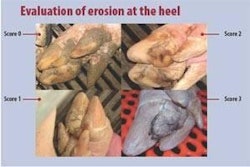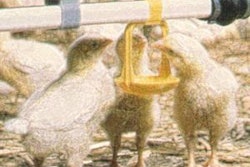Poultry's competitiveness in converting feed into meat will benefit from high feed prices, according to the Food and Agriculture Organisation's (FAO) May 2008 Food Outlook. The FAO forecasts that poultry meat production this year could expand by almost 4 percent to 92.9 million tonnes (mt). This compares with the latest estimate for 2007 of 89.5mt and some 85.4mt produced in 2006.
World meat production (excluding fish) is expected to come close to 281mt this year, or 2.3 percent more than the latest figure for 2007 of 274.7mt. However, of the anticipated increase of some 6.2mt, poultry is expected to account for about 3.4mt, or 55 percent. As poultry's rate of growth exceeds that of competitors, its share of total meat output has risen from 31.5 percent in 2006 to an estimated record 33.1 percent this year.
Table 1: Poultry meat production
Production in developing economies is expected to expand by around 5 percent to 53.4mt from last year's 50.8mt, while for developed nations a more moderate 2 percent growth is forecast, raising output from 38.7 to 39.5mt.
Although outbreaks of highly pathogenic avian influenza (HPAI) continue to apply brakes on the rate of expansion in poultry meat production, sustained economic growth in developing countries is expected to increase the demand for meat, especially for low-priced protein-rich meats such as poultry. "The cost efficiency of poultry production can be largely attributed to the relatively high feed-to-meat conversion ratios that can be achieved when compared with the production of other types of meat," states the report.
Growth is forecast for all regions of the world (see Table 2), with the increase in the USA, the world's largest producer, exceeding 2 percent as output tops 20mt.
A 6 percent gain is projected for South America with production in Argentina and Chile showing a 10 percent rise, while for Brazil, the biggest producer in the region, a 5 percent rise is anticipated. Despite recurring outbreaks of avian influenza (AI), China is expected to boost output by nearly 9 percent this year to almost 17.6mt.
Even with the resurgence of AI in parts of the European Union, total output looks likely to show little change as compared to last year, though the region is expected to become a net importer with Brazil the main supplier.
Total trade in poultry meat is forecast to increase by 4 percent, or 400,000mt, to around 9.6mt. Almost half of the anticipated rise will stem from an increase in the demand from Asia and, in particular, China, where consumers are substituting chicken for pig meat.
The Russian Federation is increasing imports as consumer demand continues to grow because of improved incomes and a shortage in supply of other meats.
On the export side, Brazil is expected to maintain its leading position and if shipments come close to 3.6mt, the country would account for some 38 percent of the forecast global expansion. The USA is expected to account for around one-third of the anticipated increase in world trade as exports climb by 4 percent, to 3.4mt.
Table 3: World meat production and trade (million tonnes)

















